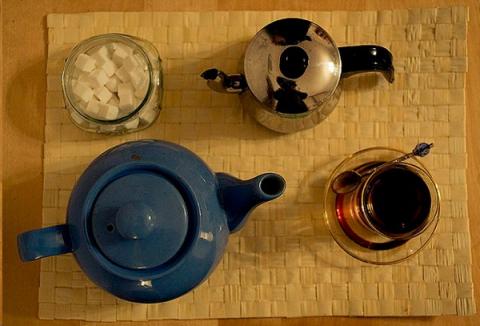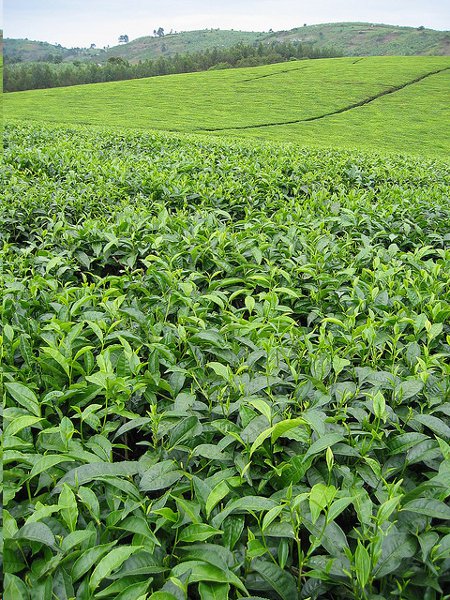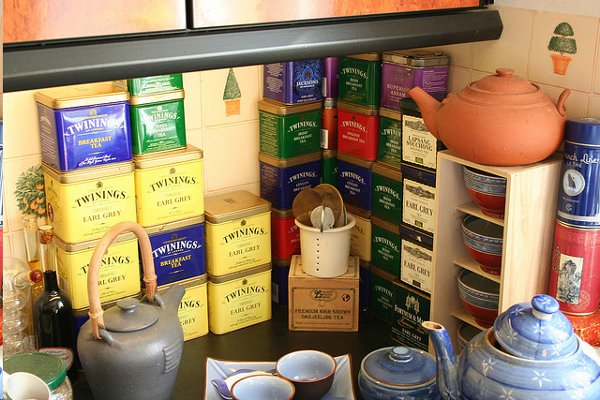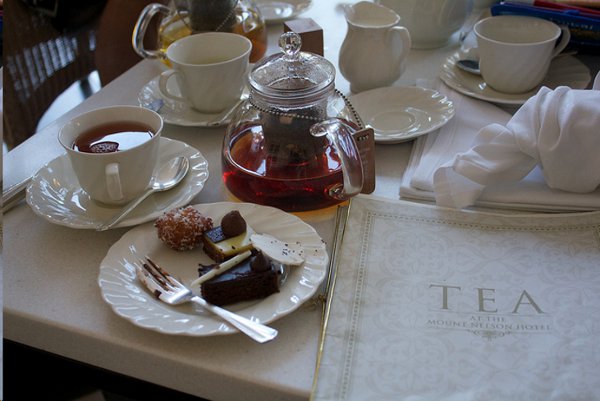A Brief (and Turbulent) History of Tea

As we all know, tea has long enjoyed an illustrious history in countries such as China, Japan, England and India. The drink, which holds claim to being the second most consumed beverage in the world, is currently experiencing a revival in the United States, thanks to revolutionized tea bags, the bubble tea craze and a general cultural resurgence.
A brief rundown: Tea is made from the fresh leaf of the Camellia sinensis bush, which was originally grown in China. There are six classes of tea -- green, yellow, white, oolong, black and puerh -- and multiple herbal teas (such as peppermint) and blended teas (like Earl Grey). Tea can be drunk hot or iced, and is prepared in a variety of ways due to cultural preferences; in Morocco for example, green tea infused with mint and sugar is extremely popular and served with froth on the surface.
Tea has been known to have antioxidant benefits, as well as vitamins beta-carotene, B2 and C, that improve the health of the drinker. Studies have also shown that tea “may help with cancer, heart disease, and diabetes; encourage weight loss; lower cholesterol; and bring about mental alertness.” Tea also contains theanine, which produces the calming effect that happens when one drinks tea.
Tea-drinking started in China. Its origins were as a medicinal beverage, and tea was traded in the form of a brick with Turkish merchants, usually along the Tea-Horse Road which linked the south-west of China to Tibet, Burma, and India. The Silk Road, which was north of the Tea-Horse Road, linked China to the Middle East and the Mediterranean, and a route known as the Siberian Route connected China to Russia, introducing tea there as well.
Tea became a very important part of life in China and Japan. The drink moved from the courts of the emperor to the upper class and middle class as cultivation techniques expanded and produced different flavors and types of tea. Tea houses sprung up in China during the Tang Dynasty (618-906) and tea rooms began during the reign of the 8th Shogun in Japan. These types of establishments were social placesmeant for relaxation, entertaining guests, discussing business and of course, enjoying tea.

It was through the Dutch and the Portuguese that tea eventually made its way to Europe. These two nations had a monopoly over trade with the East, which caused Queen Elizabeth I to charter the East India Trading Company (EIC). Around the same time, The Dutch brought Chinese and Japanese teas to Amsterdam in 1610, and proceeded to market them to countries such as Germany, France and England.
Tea gained popularity in England in the 17th century (resulting in tea houses as well), and by the 18th century became the EIC’s one and only export. The company imported roughly 13 million pounds annually into England. It also became a popular export to the colonies in America.
Tea in America
Tea was brought to America by the Dutch in 1650; specifically by Peter Stuyvesant to the colony of New Amsterdam. The drink became popular in the colonies, specifically Hyson and Bohea tea; women took cues from those in England and turned tea parties into social events. Tea was a hot commodity to the point where vendors would try to sell impersonated tea -- they would paint leaves with poisonous dyes to pass off the tea as a type of expensive green tea.

The most famous incident involving tea in America is of course the Boston Tea Party. Since 1733, the British had tried to impose taxes on the colonies, one of the first instances being the Molasses Act (British officials were lackadaisical in collecting the taxes, so this law was ignored). Following suit were the Sugar Act of 1764, the Stamp Act of 1765 and the Townshend Act of 1768, which placed duties on imports, including tea.
The colonists, specifically in Boston, were angered by the acts of the crown and decided to boycott all imports coming in from Great Britain. They still valued their tea; however, and would buy it from smugglers, whose prices were cheaper. Smuggled tea was also a huge industry in Great Britain, and the EIC was losing money fast.
Introduce the Tea Act of 1773, which allowed the EIC to directly export tea to the American colonies and not have to pay taxes. This lowered the price of the tea, which the company figured the colonists would be happy to pay. They were not for many reasons, one being that the EIC played favor to Loyalists in Boston; what followed was an act that inspired similar protests and helped sparked the American Revolution.
Post-revolution tea was still a popular drink in America and even became part of the trade. In 1833, when the EIC lost its monopoly to China, the tea trade became a free for all. This led way to the golden age of clipper ships, which were built in America and were considered the fastest ships on water. Clipper ships had been used during the War of 1812, but now they were instrumental in the delivery of goods, specifically tea and opium, which was used to trade with China. Besides delivering goods, clipper ships were also used to set records -- the James Baine clipper, for example, set an around-the-world record of 133 days. Clipper ships, however, died out with the arrival of the steamship.

Culturally, tea consumption was led by the ladies of America. They began the practice of taking “low tea” or afternoon tea, mostly for fundraisers and charities. Low tea was named so because tea was served on low tables in sitting rooms. Just like in Paris and London, the custom of afternoon tea became popular outside of the home -- it was soon served in tea rooms and hotels.
Tea rooms, like their worldwide counterparts, became very popular, especially in the 1920s. They were mostly run by women and provided an alternative to drinking alcohol during the Prohibition Era. Tea rooms and tea gardens allowed young men and women to socialize in public as well. With tea rooms, there was also the tea dance -- known as thé dansant, where individuals would participate in a Tango-style dance and drink tea.
Methods of tea drinking were revolutionized in the early 1900s -- two important incidents being the invention of iced tea and tea bags. America’s first World’s Fair was held in St. Louis in 1904; there was a tea merchant by the name of Richard Blechynden who specialized in black teas. Blechynden found it difficult to sell tea in the heat, so he began to pour it over ice. Iced tea became a very popular beverage, especially in the South where it’s known as sweet tea.
The other invention, tea bags, was created by Thomas Sullivan and revolutionized the way tea was made. For centuries and in other countries, tea was made by boiling water and pouring it over tea leaves. Dependent on personal preference, milk, sugar, cream, salt or anything else may be added to the tea. Sullivan was a tea importer and would send samples to his customers. The customers assumed the bags were meant to be used like infusers and placed the tea in pots of water.
This method of brewing tea revolutionized the industry as it made the process much easier. By the 1950s, tea bags were made of a paper fiber. These tea bags weren’t filled with long tea leaves but the remnants of leaves after being sifted and ground.
Bringing Tea Back
According to Helen Saberi, author of Tea: A Global History, “Tea-drinking is undergoing a revival in the United States.” Prior to the ‘90s, tea sales were less than $1 billion, and by 2009 they were about $6 billion.
There are many factors to this revival. Chai tea and bubble tea were two new trends introduced in the ‘90s. Chai was more popular, being sold in hot and cold variations in Starbucks and coffeehouses all over, while bubble tea is just now experiencing popularity -- Asian bakeries and tea shops sell it in cities such as New York, Boston and San Francisco.
The New York Times attributes the growth in popularity of tea to the improved quality of tea bags. Since the 1950s, tea bags were filled with leftovers from tea processing. There was a demand for better tea, which led to the existence of quality tea companies such as Harney & Sons and Twinings on the market. Premium teas, and full leaf teas are also becoming more popular due to the refined, exotic tastes – Lipton is even following suit by releasing tea bags with full leaves in them.
It seems that America is going through another tea craze, in part due to availability, accessibility and health benefits. Iced tea makes up 85 percent of the tea Americans consume, and can be found in supermarkets, delis, and restaurants. Specialty tea stores and tea lounges are cropping up in cosmopolitan cities. And every year there’s at least one article published about the benefits of drinking green or black tea with a well-balanced diet. You can also find beauty products made with green tea, such as face washes to promote clean and young skin.
If anything, the popularity of tea shows that this historic beverage is quickly gaining momentum and may just knock coffee out of the number-one spot yet.
Author Bio:
Gabriella Tutino is a contributing writer at Highbrow Magazine.
Photos: Adrian Sevitz, Sarahemcc, Alexandre Dulaunoy (Flickr, Creative Commons).




























































































































































































































































































































